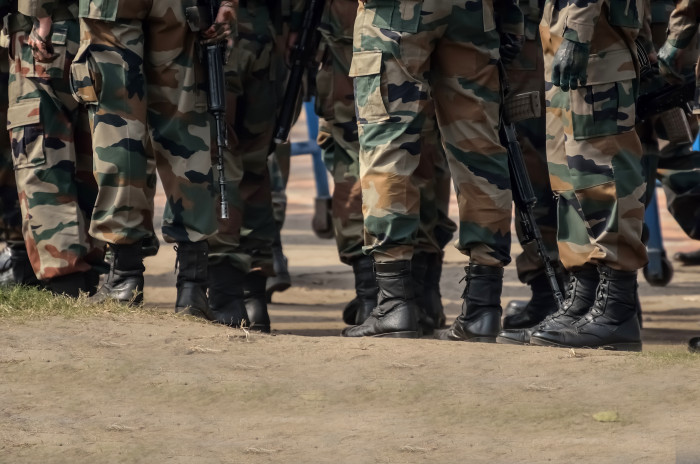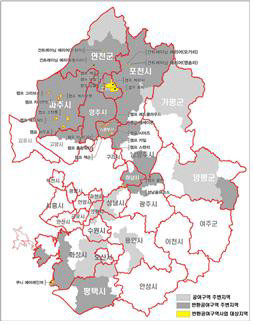경기문화재단
The Return and Development of USFK Granted Areas in Gyeonggi-do
The Return and Development of USFK
(United States Armed Forces in Korea)
Granted Areas in Gyeonggi-do Province
Writer: Lee Jihun, Director of the Center for Gyeonggi Studies

This year, 2020 is the 70th anniversary of the outbreak of the Korean War. Not only did three years of war leave us with nothing but damage and hurt, but since then, this history has had a significant impact on our politics, society, economy, and culture. Regionally, Gyeonggi-do province was the main battlefield of the Korean War and has had huge military installations as a product of inter-Korean confrontation, since the armistice. The United States, which sent 400,000 solders, has continuously maintained a certain level of troop presence, according to the ROK-U.S. Mutual Defense Treaty, signed on August 4th, 1953. During the war, the U.S. military stationed soldiers mainly in Gyeonggi-do Province, including in Dongducheon and Uijeongbu, such as 24th Infantry Division, 25th Infantry Division, 3rd Infantry Division, 7th Infantry Division, 2nd Infantry Division.
Among these, the 3rd Division was stationed for about two years from 1952 to 1954 and the 7th Division was stationed in Dongducheon for about 20 years, from 1952 to March 1971, when the troops were withdrawn. After the 7th Division’s withdrawal, the 2nd Division, which had been in charge of the western front, moved to Dongducheon. With the withdrawal of the 7th Infantry Division along with the reduction of U.S. troops in South Korea, the South Korean military is now responsible for the defense of all the truce line, but for Panmunjom. The 2nd Infantry Division has been stationed in Dongducheon up to now.
Gyeonggi-do province is the key part of the U.S. military presence, where the main unit of the U.S. Forces Korea, Command and subordinate forces of the 2nd Infantry Division belonging to the 8th U.S. Army and the 7th Air Force Command are located. In Gyeonggi-do province, there are 51 out of the 93 U.S. military bases in Korea, and the majority of them are gathered in the cities of Dongducheon, Paju, Uijeongbu, and Pyeongtaek. In addition, there have been training facilities in Hanam, Hwaseong, and Pocheon.
In March 2002, the defense chiefs of South Korea and the U.S. signed the ‘joint land management agreement’, stating that a total of 74 million pyeong of USFK’s Granted areas will be reduced to 32 million pyeong, 43 percent, by 2011, and that the main bases will be merged from 41 into 23 bases. Returning granted areas in Gyeonggi-do Province affected a total of 44 U.S. Forces Korea sites, including 6 in Dongducheon City, 9 in Uijeongbu City and 13 in Paju City. By 2011, 13 places in Paju had been returned, but only five in Uijeongbu and two in Dongducheon had been returned. Afterwards, plans were to close U.S. military facilities in Dongducheon, Uijeongbu and Seoul by December 2016 and move to Pyeongtaek, but only a few facilities were returned in 2017. An announcement was made saying that the closure of the base in Dongducheon City could be put on hold until the South Korean military would take charge of keeping North Korea's long-range artillery in check. As the inter-Korean summit in 2018 led to a discussion of North Korea's long-range artillery toward the rear, expectations have grown that the return of U.S. military bases in Dongducheon will commence. Among the 7 U.S. military bases in Dongducheon, 4 bases, Camp Casey, Hovey, Mobile, and Castle, were still unreturned. Training Camp Gimbols, Camp Nimble, and only a portion of Camp Castle where Dongyang University campus resides, have been returned.

The procedure has been delayed for a considerable period of time due to land pollution cleanup standards and the cleanup responsibilities, during the process of returning the already closed U.S. military bases, such as Dongducheon (Camp Hovey Shea, Shooting Range, Closed in October 2011), Bupyeong (Camp Market, Closed in July 2011). As requests for early return continued in the region of economic and social difficulties, due to the possibility of spreading pollution, and the disruption of development plans as a result of the return delays, the government announced in August 2019 that it would push for an early return and began consultations with the United States in December. Dongducheon city anticipates that the consultation will speed up the return of Camp Hovey or Camp Casey, which has high use value.
The most social and economic impact of the presence of the United States Armed Forces in Kore is found in the very area where the U.S. military is stationed. Prior to the resurrection of local autonomy in 1995, there was no meaningful policy in the region to deal with the U.S. Army in Korea. When the local autonomy system was fully implemented and local governments became the center of regional development, and active base closure movement began and its influence has grown. Currently, Gyeonggi-do province insists on the need for state-led development of the granted areas returned by the U.S. military in Korea, and a debate was held in the National Assembly on the theme of "The government holds the key for invigoration of the returned granted areas” in September 2019. Gyeonggi-do province, having position that the development of the returned areas should be determined by and for the residents who have made sacrifices for national security for nearly 70 years, launched in January 2020 a public-private partnership organization called the ‘Task force Team for the early return and the state-led development of the U.S. military granted areas’ for the purpose of engaging effective alternatives related to state-led development. In 2020, a total of 1.558 trillion won is planned to be invested, including 91 billion won of state funds on 59 business projects in 12 cities and counties including Uijeongbu, Paju and Dongducheon.

▲ Status map of USFK bases in Gyeonggi-do Province (as of September 2019, data from Gyeonggi-do)
In the meantime, citizens of Gyeonggi-do province have suffered a lot for security reasons. Social loss and regional problems and conflicts have been caused by the U.S. Forces in Korea as well as economic damage caused by development restrictions. Of course, the returned granted areas of the U.S. military should contribute to the improvement of the quality of life for the provincial public. On last February 14th, an opinion was presented in the TF of Gyeonggi-do, suggesting that the "development of the granted area should proceed in a way that suits the characteristics of each base and region.’ Though it's important for the government to take the lead and push ahead quickly, we should make efforts to ensure that the development will be carried out with the characteristics of the region under the effective participation of the residents.
For more information on Gyeonggi Studies Communication? [Click here] |
<ggc의 모든 콘텐츠는 저작권법의 보호를 받습니다.>